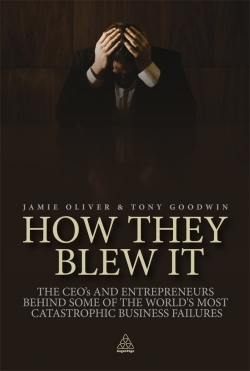How They Blew It
The CEOs and Entrepreneurs Behind Some of the World's Most Catqastrophic Business Failures
Like it or not, people are fascinated by other people’s troubles. All one has to do is observe how drivers slow to examine an automobile accident they come upon to recognize this aspect of human nature. It is precisely this fascination that makes reading How They Blew It by Jamie Oliver and Tony Goodwin so alluring. But this book is more than mere voyeurism in that Oliver and Goodwin use these vignettes as instruction for other entrepreneurs in how to avoid disaster.
The authors are well qualified to lead this discussion. Oliver is a British-based journalist experienced in writing for business and financial publications. Goodwin is an entrepreneur who has experienced firsthand the risks and rewards examined in the book.
How They Blew It is organized into sixteen principal chapters, each one giving a brief account of the collapse of a particular entrepreneur’s empire. The reader is introduced to such characters as Bernie Ebbers, the sometime Sunday school teacher and full-time business deal maker, who directed the rise and fall of WorldCom and went to prison for twenty-five years. There is a chapter devoted to Ken Lay, the infamous and brilliant leader of Enron, one of the most spectacular collapses in American business history. Included among other curious cases is the saga of Jon Asgeir Johannesson, the Icelandic retailer, who failed in business and helped bankrupt the financial system of an entire nation.
In their introduction, Oliver and Goodwin speculate on why it is that only men are represented in their book. “So why do no women feature? It might be something to do with legacy—and the propensity to take risk.” The authors never offer a thorough answer to their own question. But it should be noted that in at least two of the cases addressed in How They Blew It, the leading miscreant was brought down partially by the whistle-blowing efforts of an honest woman.
At the end of their examination of these business failures, Oliver and Goodwin offer lessons that can be learned from these stories. Among the more noteworthy are: money, wealth and success do not necessarily equate with intelligence; pay attention to what you know and what the customer wants; and beware of greed.
Oliver and Goodwin have not offered comprehensive, in-depth textbook case studies of these business flops. Instead, they have delivered a readable, well-referenced enticement to those who are in business or who are contemplating a business venture. Perhaps the biggest lesson to be gleaned from How They Blew It is that an overdose of hubris can be a lethal business partner.
Reviewed by
John Michael Senger
Disclosure: This article is not an endorsement, but a review. The publisher of this book provided free copies of the book and paid a small fee to have their book reviewed by a professional reviewer. Foreword Reviews and Clarion Reviews make no guarantee that the publisher will receive a positive review. Foreword Magazine, Inc. is disclosing this in accordance with the Federal Trade Commission’s 16 CFR, Part 255.

